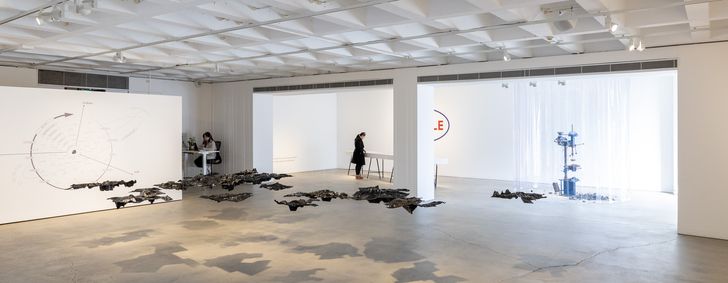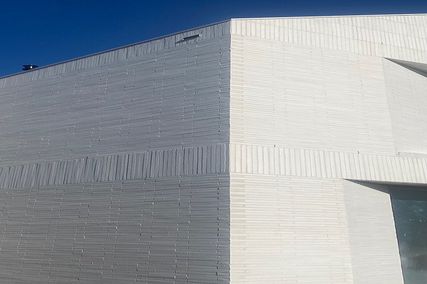Fossil Fables takes aim at Australia’s complex and seemingly unwavering relationship to coal, drawing on material gathered from the Hunter Valley Region, the historical “engine room” of Sydney. The exhibition by The Global Extraction Observatory (GEO), headed by Eduardo Kairuz and Sam Spurr, in collaboration with D’Arcy Newberry-Dupe and Bud Rizk, shows how Sydney is entangled in the ambitions and terrors of the hinterland that sustains it. The valley contains the first site of coal extraction on the continent – a ship full of coal left from the coastal town of Newcastle to India in 1799 – and has been home to continuous extraction ever since. Today, Newcastle has the world’s largest active coal port.
The first work brings the viewer directly into this site of contradictions: Terminal Void is a suspended collection of 1:10,000 scale models of open pit mines in the Hunter Valley region. In jet black photopolymer oil-like resin, they seem to have been poured into the contours of the extraction pits, and appear to be magically suspended in the air. The different mines are positioned according to their relative location – a kind of exploded map of coal infrastructure that the vineyard cellar door tourists in the region can never see. Indeed, much effort has been made to hide these pits and their infrastructure from the tourist routes, with trees and artificial hills making them visible only by satellite or with security clearance and authorization. Visitors to the region’s wine, wedding and eco-tourism infrastructure see a different valley, even though these ecologies and their consequences are inseparably linked.
Terminal Void is a suspended collection of 1:10,000 scale models of open pit mines in the Hunter Valley region.
Image: Courtesy GEO
What will be done with these massive excavations, and all their remnant toxins in the Hunter River? The artists question whether coal mining is itself a form of architecture, insofar as it involves the relocation of materials into bespoke, spatial configurations, brought on by political and economic means – and still serving, whether we want to admit it or not, a vital social purpose. Behind the work, a complex text-based diagram with the blown-up words “scale”, “matter” and “violence”, draws the viewer toward smaller, isolated terms like “cobalt”, “coltan” and “copper”. For the artists, this diagram visualizes the themes, sites and methods of engagement that constitute extractivism. Still, it seems to be more focused on producing a sense of interconnection than on clarifying the ties that bind this system together.
A work unique to the Australian conjuncture is Lump, in which a series of photographs depict the bodies (sans heads or faces) of Australian politicians handling a lacquered, fist-sized coal specimen from the Hunter region across the back wall of the gallery. Locals will recognize the outlines of climate denying parliamentarians, as part of a publicity stunt initiated by the then-prime minister Scott Morrison in 2017. The chunk of coal had been sprayed with a fixative that made it shiny and clean – Australia’s “clean coal” lies writ small. By showing only the bodies, not the faces, we are both shocked at the integration of coal into politics and also at the inescapable complicity: we are all, effectively, holding this sanitized coal, pretending we can avoid its deadly consequences while supporting the resource-extractive system with our daily activities, professional commitments, and personal aspirations.
Lump, a series of photographs depicting the bodies (sans heads or faces) of Australian politicians handling a lacquered, fist-sized coal specimen from the Hunter region.
Image: Courtesy GEO
Another large work central to the exhibition, Finite consists of an archaic drill press holding coal on its base plate. The specimen is in the process of being crushed, with chunks lying strewn on the ground. The entire scene is wrapped in a circular PVC curtain that seems to keep the viewer safe from contamination while emitting a strange glow in the gallery’s light. The work has been cleverly sited near the gallery’s large street-facing window, framed for pedestrians in and out of opening hours – doubling and thereby reaffirming the framing devices that separate this essential infrastructure from everyday life.
A long table vitrine with the original Humble Oil and Refining Company advertisements in Life Magazine from the 1960s forms a powerfully mediated set of objects. One of the ads, highly circulated on social media, reads “Each Day Humble Supplies Enough Energy to Melt 7 Million Tons of Glacier!” Humble has gone on to become ExxonMobil, one of the largest oil corporations in the world.
A Humble advertisement from Life Magazine in the 1960s.
Image: Courtesy GEO
Fossil Fables presents a challenging experience of a collective living contradiction. It is an exemplar of recent architecture exhibitions waking up to and rejecting their fossil-fuelled sponsorship and the colonial landscapes of power that make their displays possible. Take, for example, professionals boycotting the Chicago Architecture Biennale because of its sponsorship by British Petroleum. The theme for the 2023 Venice Architecture Biennale explicitly focused on decarbonization and decolonization.
For visitors of Fossil Fables, the pump is primed to act against fossil fuels and toward the care of landscapes near and far, but opportunities for transformation remain obscure. They will need to work with others to connect the dots between exploitation happening in the city and hinterland, in the exhausted communities that coal extraction creates.
Fossil Fables was exhibited at the Tin Sheds Gallery from May 18 from July 8 2023. The exhibition catalogue, edited and designed by Therese Keogh, features words by Andrew Brooks, Kate Goodwin, Bianca Hester, Therese Keogh, Sara C. Motta, and Joel Sherwood-Spring.
























